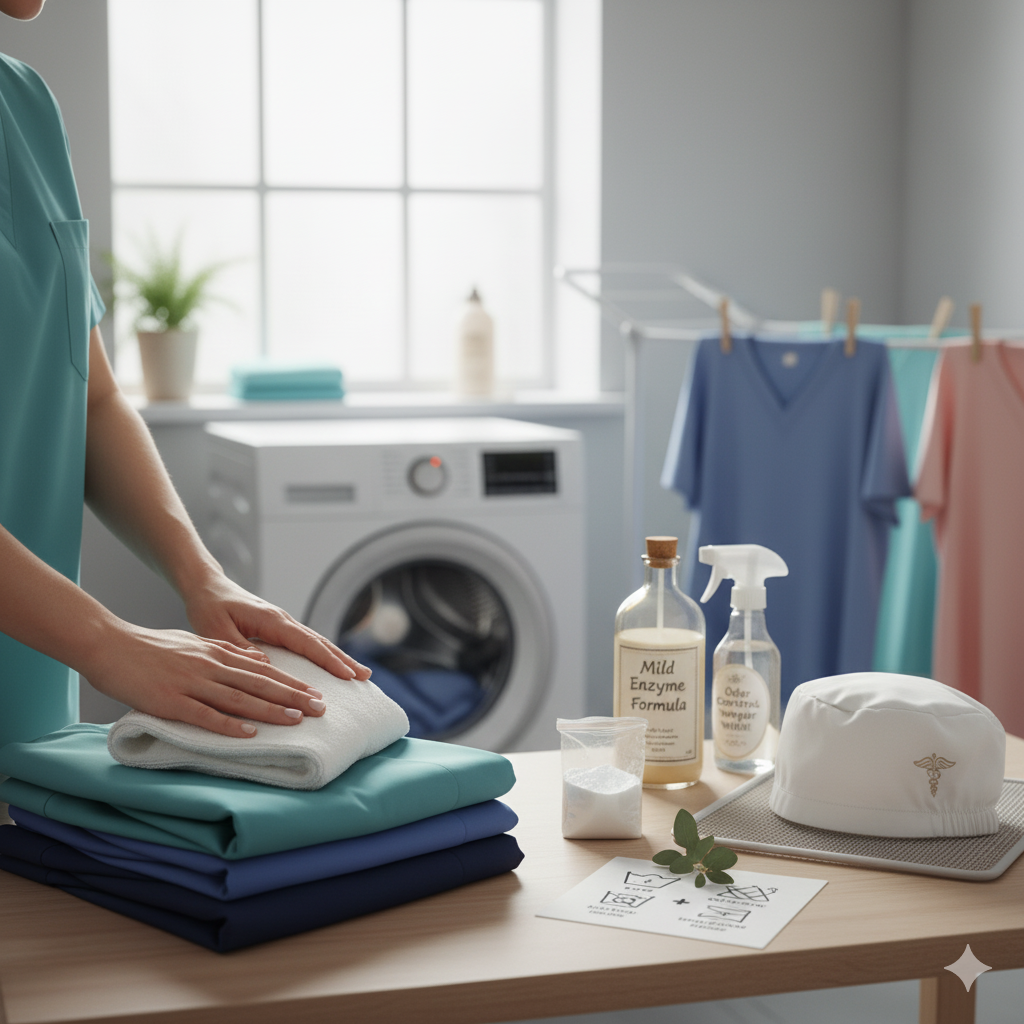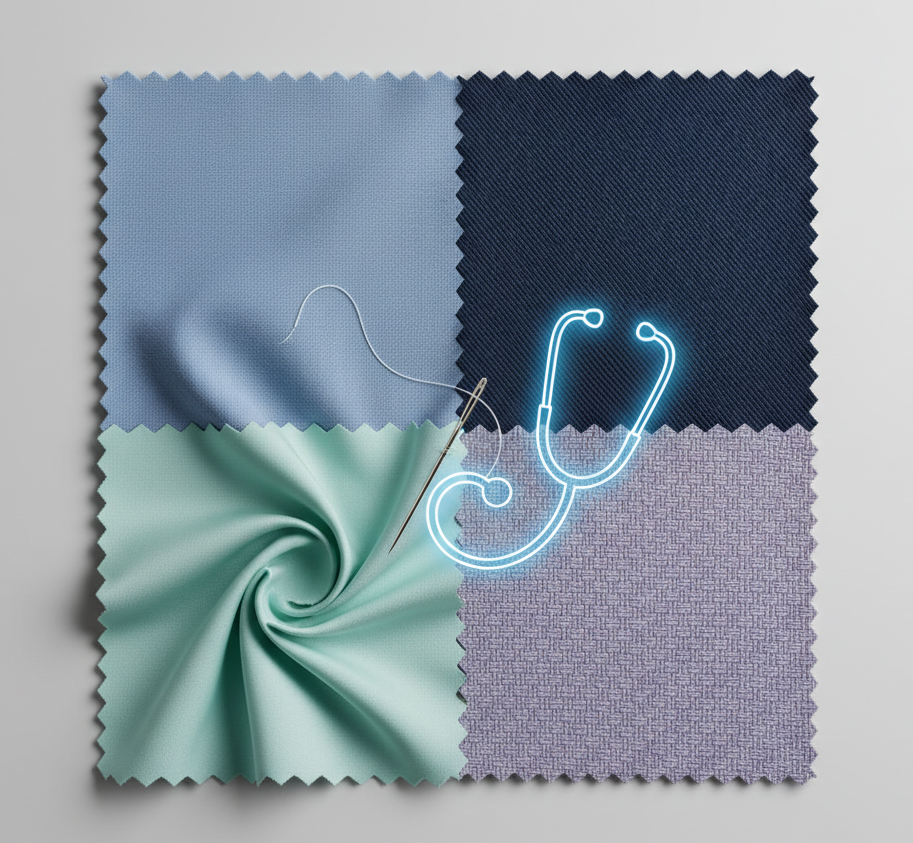How to wash scrubs
The real-world laundry guide for healthcare uniforms.
You come home from another 13-hour shift — glassy-eyed, sore-backed, and ready to melt into a break you probably earned ten hours ago. But waiting in the corner? That pile of scrubs from yesterday. And possibly the day before.
They don’t just look rumpled. They smell like adrenaline, sweat, sanitizer… and you.
And while tossing them in on hot with half a cup of detergent seems tempting, there’s a catch: That “quick wash” approach can quietly ruin your scrubs — causing fading, shrinkage, stiffness, sour odors, or outright fraying way too soon.
Here’s the truth: most scrubs don’t wear out — they get washed out.
But how to wash scrubs in the right way? This article is your no-fluff, fabric-conscious guide to doing it better.
Whether you wear cotton, polyester-blend, or premium stretch fabric, and especially if your uniform includes cotton scrub caps like ours, this is the long-haul method for keeping your gear looking and feeling clean. Let’s find out what is the best way to wash scrubs and wash smart.
How to Wash and Care for Medical Scrubs
Let’s start with the basics. Before we throw technical advice around, we need to understand where the routine starts. Washing and caring for scrubs truly begins with how often — and how well — you clean them.
How Often Should You Wash Scrubs?
After every shift. That’s it. No exceptions.
Scrubs get exposed to skin particles, body fluids, airborne bacteria, residual medication, and environmental stressors from hospital air. Even if they look clean, your uniform carries invisible elements that shouldn’t go home — or back to the floor — without a proper wash.
And yes, this absolutely includes your scrub cap. Cotton scrub caps — especially those fitted and absorbent styles — soak up sweat through the forehead and attract oils, hair product, and bacteria from the scalp.
Wash after every wear. No shortcuts. How to wash scrubs after a shift should be second nature — clean gear isn’t just about looks, it’s safety.
Pro tip: Keep two scrub caps in rotation minimum, so one has time to fully dry before the next shift.
Do Healthcare Workers Wash Their Own Uniforms?
In short: almost always.
While some hospital systems (mostly ORs or ICU teams) provide internal laundering, the vast majority of healthcare workers — RNs, dental assistants, medtechs, pharmacists, student externs — are responsible for personal laundering of uniforms. This includes scrub tops, pants, jackets, and surgical caps worn in general-care environments.
The challenge is making sure multiple washes don’t wear them out too quickly. That’s why preparation matters just as much as detergent.
Pre-Wash Preparation
Washing scrubs properly doesn’t start with hot water — it starts with observation. Before anything touches detergent, it’s worth checking for damage, weak seams, stains, or label instructions. These few moments protect your most worn-in and most expensive sets. Treating scrubs properly starts before the machine opens.
Reading Care Labels and Fabric Types
Every uniform has a care tag — and that tag matters. Read it before throwing your clothes in a “normal” cycle. Fabric guides your routine:
- 100% cotton scrubs/caps → Soft, breathable, but shrink-prone. Cold wash, air dry.
- Poly-cotton blends → More wash-tolerant, color-stable, medium durability.
- Polyester/spandex/rayon → Popular for stretch, but vulnerable to heat and friction. Wash inside-out on gentle.
- Scrub caps (cotton) → Usually not pre-shrunk. Best washed cool and shaped while damp.
At our store, we use soft structured 100% cotton for our scrub caps to maximize comfort and breathability — but that means they respond strongly to heat. A little care goes a long way toward keeping their form intact.
Pre-Treating Stains and Odors
Healthcare settings come with grime: blood, coffee, iodine, pen ink, sweat, even the occasional unmentionable. The longer these live in your scrub fibers — the harder they are to lift.
Pre-treatment checklist:
- Turn scrubs inside out
- Focus on high-friction zones (collar, underarms, knees)
- Use mild enzyme stain removers or vinegar + baking soda for odor
- Soak isolated stains 10–15 minutes prior to machine wash
- Dab, don’t scrub — especially on scrub caps with embroidery or seams
Cotton scrub caps often develop salt lines or body oil buildup in the sweatband. Soaking just the headband section for 10 minutes before washing scrubs preserves both softness and fit. Learning how to wash scrubs properly means knowing where odor builds up fastest — and how to break it down before the main cycle even starts.
Washing Scrubs at Home
Once scrubs and caps are prepped, it’s time to wash. And this is where most uniforms win or get wrecked. The choices you make from here — water, detergent, machine settings — will determine whether your gear lasts months or just a few cycles.
Best Detergents and Washing Settings
You don’t need an industrial-strength detergent to clean scrubs effectively — but you do need one that’s up to the job. Medical professionals need solutions that balance hygiene with fabric care, especially for daily uniforms. The goal is to remove bacteria and body residue without harsh ingredients that damage fibers.
Here’s what to look for in detergent:
- Mild formula, enzyme-based if possible
- Free of brighteners, softeners, and chlorine bleach
- Safe for color and labeled for cold or warm water
- Antimicrobial additives for an added clean (optional)
Suggested washing machine settings:
- Water temp: Cold for cotton/stretch/colored scrubs; warm (not hot) for poly-cotton uniforms
- Cycle: Gentle or normal (never heavy duty)
- Spin: Medium
- Add-ons: White vinegar in the rinse cycle helps with odor and build-up prevention
Healthcare laundry isn’t just grab, wash and go. To ensure the fabric lasts through weekly cycles, you need to wash and scrub it properly. That includes pretreating tough areas before tossing your uniform into the machine. Keep scrub caps out of high-heat cycles. Caps made from 100% cotton tend to shrink at sustained high temperatures, especially if they include interior bands.
Hand Washing vs. Machine Washing
Of course there are no scrubs washing machine, but there are some options which allow to wash scrubs in the machine without damaging. At the same time, hand washing still has its place, particularly for lightweight blends and specialty items like cotton scrub caps. Here we will discuss how to wash scrubs for both options.
When to hand-wash scrubs and caps:
- If they’re part of your premium set
- If they’re cut from delicate or printed fabric
- If you're traveling or between shifts
How to hand wash safely:
- Fill your sink or basin with cool–warm water (not hot)
- Add mild detergent and let the clothing soak for 10–15 minutes
- Gently agitate — no wringing/stretching
- Rinse well with cold water
- Press gently inside out and lay flat or hang to dry
This is especially important for our cotton scrub caps, which benefit from a careful soak and flat-drying to preserve the curved shape of the crown and ties.
Drying and Ironing Tips
Scrub washing cleans the garment. Drying and ironing define how long it will last. This final stretch of the routine is where small mistakes — like too much heat or careless folding — can undo everything you did right during washing.
Dryer or Air Dry?
Before choosing the best way to wash scrubs and to dry them, know your material.
- Heat is the #1 cause of shrinkage in 100% cotton.
- Stretch and rayon blends tend to thin and lose elasticity under prolonged heat.
- Excess friction in the dryer drum wears down seams, especially on joggers and high-use pockets.
That said, dryers aren’t banned. They just require moderation.
Smart drying strategy:
- Tumble dry on low or medium for 10 minutes.
- Remove while still slightly damp and air dry the rest.
- For scrub caps, skip the dryer completely and lay flat (or over a rounded surface) to avoid distortion.
How to Iron Without Damaging the Fabric
Ironing can give scrubs the crisp, clinic-ready silhouette many professionals prefer — but ironing isn’t for all fabrics.
Ironing guide by fabric:
- Cotton (tops or caps): Medium heat with steam, reverse side.
- Poly blends: Low heat, no steam, always test on hidden edge first.
- Rayon/stretch: Avoid ironing if possible, or use a garment steamer.
For scrub caps, ironing the inside-facing fabric helps preserve exterior shape. A lightly steamed crown (no hard creases!) can help you look polished without damaging band seams.
Keeping Scrubs Fresh Over Time
“Clean” doesn’t always feel clean. Sour-smelling scrubs straight out of the machine? It’s more common than you think. And when you're in medical settings surrounded by constant movement, sweat, and sterilization agents — that "almost clean" feeling isn’t good enough.
Why Scrubs Smell After Washing
That musty smell is usually due to:
- Using too much detergent
- Washing in lukewarm/cold water without sanitizing
- Letting damp scrubs sit before drying
- Improper storage (e.g. sealing them in plastic or gym bags)
Solutions:
- Use white vinegar or baking soda in every 4th wash
- Air-dry in open space (not in bathrooms or lockers)
- Add a drop of essential oil (tea tree, eucalyptus) in rinse
- Wash immediately after wear, not two days later (The longer bacteria sit on fabric — or pass from your hands to damp uniforms — the harder they are to neutralize with detergent alone.)
Cotton caps, especially in warm climates, absorb forehead and scalp oils that linger even post-wash. This is why soaking is recommended especially for caps made of 100% cotton. A quick pre-wash soak once a week — even in just cold water with a splash of vinegar — will help break down lingering odors where detergents can’t reach. Letting your scrub caps air dry thoroughly, preferably laid flat or over a rounded surface, will also help prevent mildew or musty smells from appearing at the base of the fabric or around the elastic seams.
How to Prevent Shrinking and Wear
Your scrubs and caps aren't just uniforms — they're tools. And tools wear out fast if you treat them casually in the laundry room.
What causes scrubs to shrink or break down prematurely?
- Excessive heat in the dryer or during washing
- Overloaded machines, which increase tension and twist fabric
- Aggressive detergents that strip softness and fade color
- Neglecting to turn garments inside out, exposing prints/logos
- Skipping garment care for delicate cotton caps, especially if they have tight stitching or embroidery
How to preserve your gear:
- Always wash in cold or warm water — never hot, unless absolutely necessary
- Use garment bags for lightweight or high-wear sets
- Wash scrub caps inside out, especially if embroidered — then reshape while damp
- Iron sparingly, using only medium-low heat when fabric allows
- Rotate your sets — overusing just one or two pairs wears them down fast
If you want your cotton scrub caps to hold their shape and last hundreds of wears, avoid twisting or wringing them. Instead, gently press excess water out using a clean towel, reshape the crown, and let them dry on a flat surface. Even small shifts like this can double the life of cotton-based headwear.
When to Replace Old Scrubs
Even the most well-cared-for scrubs eventually need to give way. While you can wash them carefully, there are some signs that the lifespan is coming to an end — not necessarily because they’re dirty, but because they’re no longer performing.
You should retire scrubs if…
- The fabric becomes translucent, especially in high-stress areas.
- Elastic or seams are stretched and no longer snap into place.
- They lose shape after drying or fit unevenly.
- The color is visibly faded, and the set no longer matches.
- The scrub cap sags or no longer fits snugly to your forehead or crown.
- Residual odors remain even after repeated deep-cleaning attempts.
- You no longer feel comfortable or confident wearing them in clinical spaces.
When that moment comes, donate what you can (some vet clinics gladly accept old sets), and replace what matters. Think of it less like throwing out clothes, and more like retiring old protective gear. You're not just dressing to look good — you're suiting up to work better.



